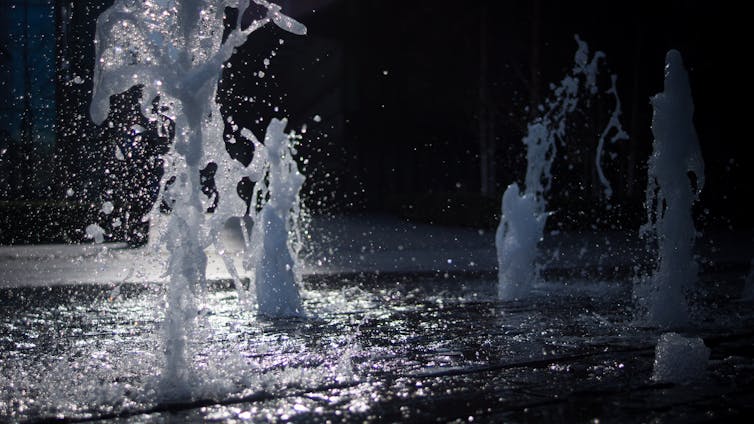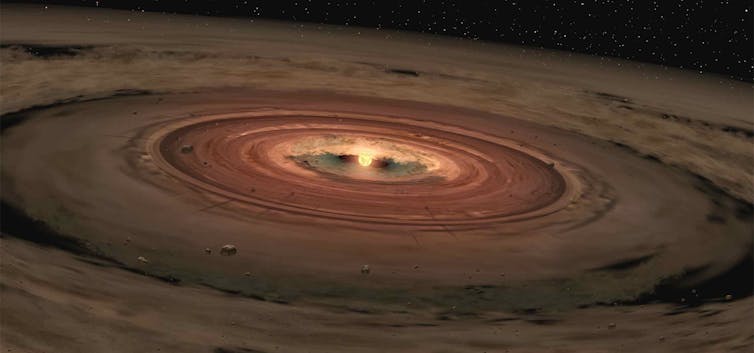Curious Kids: Why is the Earth round?
- Written by Jonathan P. Marshall, Vice Chancellor's Post-doctoral Research Fellow, UNSW
This is an article from Curious Kids, a series for children. The Conversation is asking kids to send in questions they’d like an expert to answer. All questions are welcome – serious, weird or wacky!
Why is the Earth round? – Zoe, age 3, Sydney.
Thank you, Zoe, for your great question. Asking questions like this is a really important part of being a scientist.
Imagine the Earth pulling everything it is made up of, all of its mass, towards its centre. This happens evenly all over the Earth, causing it to take on a round shape. Let me explain what I mean by that.
To understand why the Earth is round we need to look at two things - mass and gravity.
Every single thing in the universe has mass - from the biggest star to a tiny grain of sand. People, too, have mass. The more big and dense something is, the more mass it has. So an elephant would have more mass than a mouse, for example.
More mass means more gravity
While you might not be able to see it, all objects with mass are actually being pulled towards each other by a force called gravity. The bigger the mass of something, the stronger its pull.
Have you ever wondered why if you drop something, it falls towards the Earth and not up into the sky? Or the reason why we’re all stuck to the ground?
 From the moment water is flung upwards, gravity is working to pull it back down.
David Simmonds/flickr, CC BY-SA
From the moment water is flung upwards, gravity is working to pull it back down.
David Simmonds/flickr, CC BY-SA
That’s because of gravity. Because the mass of the Earth is so much bigger than the mass of people (or spoons, or vases, or water), we’re all strongly pulled towards it, which is why it feels like we’re stuck to the earth’s surface.
Read more: Curious Kids: What plants could grow in the Goldilocks zone of space?
Not everything in space is round
Part of what makes a planet a planet is its round shape. But most things in space are not perfectly round at all! In fact, some things are very lumpy. The reason for this is the way planets are made.
Planets are made of rock, ice, and gas. Before becoming a planet, the rocky and icy parts are small lumps, no bigger than sand grains, moving around the young Sun.
 An accretion disk, made from gas rock and ice, similar to the one that formed our Solar system billions of years ago.
NASA/JPL-Caltech
An accretion disk, made from gas rock and ice, similar to the one that formed our Solar system billions of years ago.
NASA/JPL-Caltech
Over millions of years, gravity pulled the small rocky and icy parts towards each other until they started to stick together. Eventually these small parts grew from the size of sand into the size of mountains.
These mountains of rock and ice are fluffy, like giant dirty snowballs. So the small mass - and weak gravity - of the whole mountain is unable to overcome the hard shape of the rock and ice lumps to become round.
Read more: Curious Kids: Why do stars twinkle?
Fluffy mountains like these got swept together billions of years ago to make the planets we recognise today. But some of them are still minor objects in the Solar system. These bits of leftover planet-building material, called asteroids and comets, have very lumpy shapes. Some are shaped like potatoes and others like eggs.
 A comparison of asteroid sizes, including Ceres and Vesta, the two largest objects in the asteroid belt.
NASA/ESA/STScI
A comparison of asteroid sizes, including Ceres and Vesta, the two largest objects in the asteroid belt.
NASA/ESA/STScI
The largest of these minor bodies, such as Ceres and Pluto, have enough gravity to look round like a planet. They are called dwarf planets. Some, like Haumea, spin very fast, giving them an stretched shape, like this:
Hello, curious kids! Have you got a question you’d like an expert to answer? Ask an adult to send your question to us. You can:
* Email your question to curiouskids@theconversation.edu.au * Tell us on Twitter by tagging @ConversationEDU with the hashtag #curiouskids, or * Tell us on Facebook
 CC BY-ND
Please tell us your name, age and which city you live in. You can send an audio recording of your question too, if you want. Send as many questions as you like! We won’t be able to answer every question but we will do our best.
CC BY-ND
Please tell us your name, age and which city you live in. You can send an audio recording of your question too, if you want. Send as many questions as you like! We won’t be able to answer every question but we will do our best.
Authors: Jonathan P. Marshall, Vice Chancellor's Post-doctoral Research Fellow, UNSW
Read more http://theconversation.com/curious-kids-why-is-the-earth-round-80311



